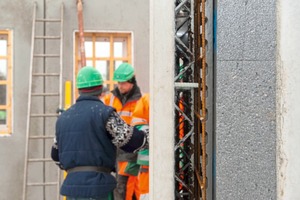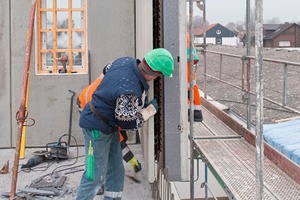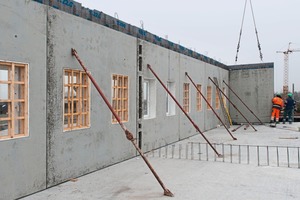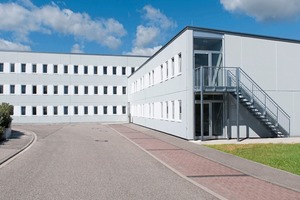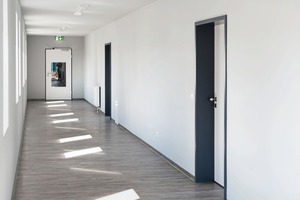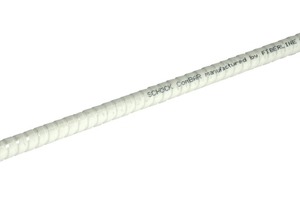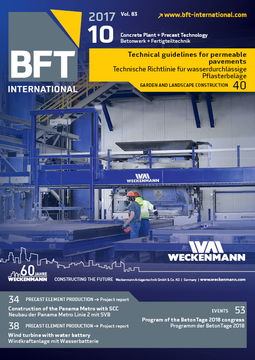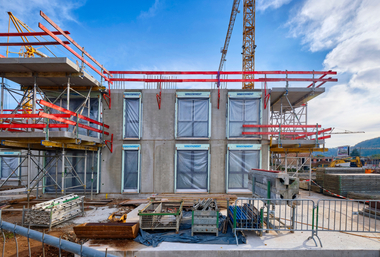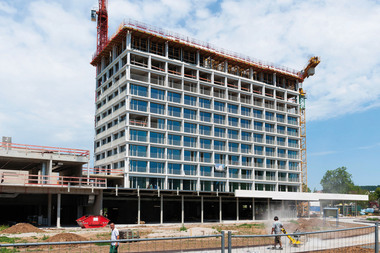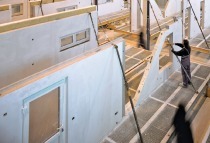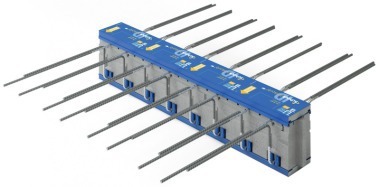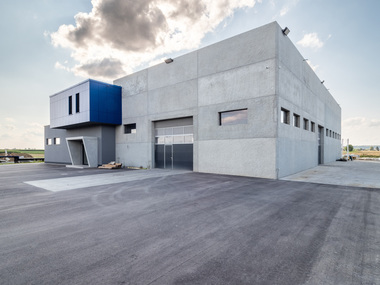Modular design for refugee accommodations
The Oberhausen-Rheinhausen community in the administrative district of Karlsruhe was faced with the same issues like many other communities in Germany after 2015: How to provide refugees with appropriate living space as soon as possible? The administrative district of Karlsruhe decided to develop the property of a former window manufacturer. The new building made of precast concrete elements is built in modular design and can be used for social housing later.
The general contractor, Hermann Laier GmbH & Co. KG located in Forst, acquired the property and converted the existing factory hall into temporary shelter for refugees. Soon afterwards, the production of the precast concrete elements was already started as well as the construction of the modular residential building providing living space for more than 140 people on 2,000 m².
Building with distinction
In the preliminary stages, Laier already thought about the special features which had to be taken into account when planning with precast concrete elements. On the one hand, the dimension of the precast element is limited by the weight which the crane is able to lift on the construction site. On the other hand, it was important to pay attention to the joint pattern: The expansion joint of the façade is absolutely necessary and serves to compensate temperature fluctuations. Laier planned the elements with a height of 2.87 m from unfinished floor to unfinished floor of the story above, but featuring four different widths. He achieved the joint pattern desired by combining façade elements with widths of 6.00 m, 4.59 m, 3.38 m and 1.68 m. The joints do not run in a vertical line along the three stories, but can be arranged in a staggered design. In this way, the regularly arranged windows get an architectural counterpart. A total of 946 m² of façade elements are used up in building.
“We have realized the façade with core-insulated wall elements,” says Laurent Heintz of Fehr, the manufacturer of precast concrete elements. “The solution with the already insulated external walls shortens the construction time extremely, because it saves several working steps on the construction site. There was no need for elaborate insulation works, nor further plastering,” continues Heintz, who was also responsible for the assembly of the modular units on site. The interior walls of the building are designed as double walls, too. A precast slab which is complemented by in-situ concrete after assembly is used for the floors. This also reveals another advantage of precast concrete construction − apart from the fast construction time: Due to placing the concrete horizontally on the formwork tables at the factory, the floor and wall elements get a very nice and dense architectural concrete surface in a consistently high quality because vibration mechanism of the table compacts the concrete uniformly.
Connector and spacer
“An important aspect for the construction of the core-insulated element wall is that the connection of the facing shell and the supporting shell is free of thermal bridges,” says Alexander Hettler of Schöck Bauteile GmbH. For this purpose, the Schöck Thermoanker was used. The Schöck Thermoanker connects the outer shell to the inner concrete shell of the element wall ensuring the least possible thermal bridge. It can even be neglected in the calculation of the U-value. The geometry of the thermal anchor makes the installation at the precast concrete plant very easy. Since the Schöck Thermoanker is a circular rod made of glass fiber composite and can be easily inserted in the pre-drilled insulation up to the formwork bottom. Because of the slanted ends, the Schöck Thermoanker meets the formwork bottom just with the smallest point, thus being invisible on the outside.
The pre-drilled thermal insulation boards are placed on the fresh concrete of the facing shell at the factory. The anchor is inserted in the concrete up to the fromwork bottom through the drilled hole of the insulation board. After hardening in the curing chamber, the facing shell is turned and the anchor immerses in the fresh concrete of the supporting shell. Hence, the Schöck Thermoanker acts as both connector and spacer simultaneously.
Precast element and window become one
“It was quite thrilling, when Christoph Laier expressed the request that the windows should be integrated into the wall elements right at the factory. This was a new situation for us, and we found a solution for the wall with insulation together with the window manufacturer. Because the window element - just like the wall - had to consist of two parts. A window element was embedded in concrete in the facing shell and the adequate counterpart in the supporting shell. The two window elements make up a unit only when turning the two precast elements,” Heintz states.
“In October 2016, we started with the production of the elements and according to the specification the shell construction had to be completed by Christmas,” Heintz remembers the tight schedule. On site, a steel rope at the base can be attached to the crane without ladder or chains. After the alignment of the façade element, the rope is put into the cavity between the two slabs, being filled with in-situ concrete as usual. “We have been using this system in France for several years because ladders are not allowed at construction sites there owing to safety reasons,” Heintz explains the invention.
Sustainable concept
The main objective of the project was to place people from emergency shelters in a more comfortable environment by fast action. The advantages of precast construction allowed us to realize the project in the shortest possible time. As soon as the refugees move from the emergency shelter in the old factory building into the new homes, the hall will be demolished and further living units will be built on the property. After completion, there will be two identical buildings which are placed in L-shape next to and mirroring each other.
The building is planned in a modular design so as to allow the conversion into social housing. A convincing and sustainable concept.

